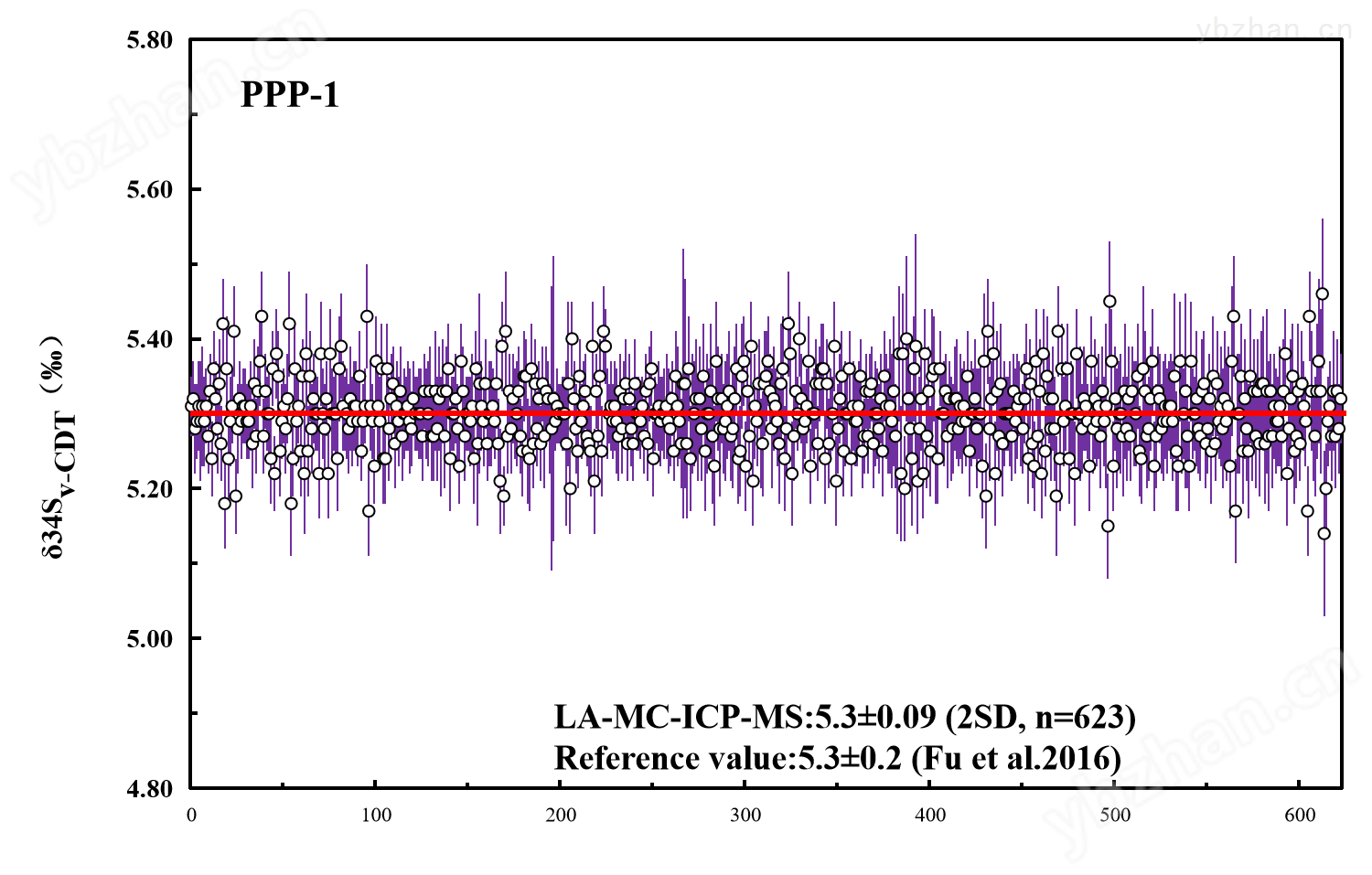测试周期:来电详询
送样要求:样品靶或岩石薄片,薄片尺寸参见原位主微量元素分析要求。
完成标准:测试内精度及标样外精度和准确度确保达到国际水平。

方法描述:
22.1 硫化物 LA- MC- ICP-MS 微区原位 S 同位素比值测试
微区原位硫化物硫同位素比值测试在武汉上谱分析科技有限责任公司利用激光剥蚀多接收杯电感耦合等离子体质谱(LA-MC-ICP-MS)完成。激光剥蚀系统为Geolas HD(Coherent,德国),MC-ICP-MS为Neptune Plus(Thermo Fisher Scientific,德国)。激光剥蚀系统使用氦气作为载气。分析采用单点模式,为了解决分析过程中硫同位素比值的Down Hole分馏效应(Fu et al. 2016),选择采用大束斑(44微米)和低频率(2Hz)的激光条件,单次分析约剥蚀100个激光脉冲。同时配备了信号平滑装置(Hu et al . 2015),确保在低频率条件下获得稳定的信号。激光能量密度固定5.0 J/cm 2 。质谱仪Neptune Plus配备9个法拉第杯和10 11 欧姆电阻放大器,采用L3,C和H3三个法拉第杯同时静态接收 32 S, 33 S和 34 S信号。高性能的Jet+X锥组合被采用提高信号强度。氮气(4 ml/min)被引入等离子体降低多原子离子干扰。中分辨模式(约5000)被采用。硫同位素质量分馏采用SSB方法校正。为避免基体效应,黄铁矿、磁黄铁矿、镍黄铁矿等样品采用黄铁矿参考物质PPP-1校正。黄铜矿样品采用国家黄铜矿标准物质GBW07268的粉末压片校正。硫化银样品采用国际硫化银标准物质IAEA-S-1的粉末压片校正。以上样品δ 34 S v-CDT 推荐值请参考Fu et al.(2016)。测试过程中,实验室内部磁黄铁矿参考物质SP-Po-01(δ 34 S v-CDT =1.4±0.4),黄铜矿参考物质SP-CP-01(δ 34 S v-CDT =5.5±0.3)和国际硫化银标准物质IAEA-S-2(δ 34 S v-CDT =22.58±0.39)和IAEA-S-3(δ 34 S v-CDT =-32.18±0.45)作为质量监控样品被重复分析,验证实验方法的准确性。详细的仪器操作条件和分析测试方法可以参考Fu et al.(2016)。全部分析数据采用专业同位素数据处理软件“Iso-Compass”进行数据处理(Zhang et al., 2020)。
22.2 In-situ S isotope analysis of sulfide by using LA-MC-ICP-MS
In situ sulfur isotope analyses of sulfide were performed on a Neptune Plus MC-ICP-MS (Thermo Fisher Scientific, Bremen, Germany) equipped with a Geolas HD excimer ArF laser ablation system (Coherent, Göttingen, Germany) at the Wuhan Sample Solution Analytical Technology Co., Ltd, Hubei, China. In the laser ablation system, helium was used as the carrier gas for the ablation cell and was mixed with argon (makeup gas) after the ablation cell. The single spot ablation mode was used. Then the large spot size (44 μm) and slow pulse frequency (2 Hz) were used to avoid the down hole fractionation effect which have been reported by Fu et al . (2016). 100 laser pulses were completed in one analysis. A new signal-smoothing device was used downstream from the sample cell to efficiently eliminate the short-term variation of the signal, especially for the slow pulse frequency condition (Hu et al . 2015). The laser fluence was kept constant at ~5 J/cm 2 . The Neptune Plus was equipped with nine Faraday cups fitted with 10 11 Ω resistors. Isotopes 32 S, 33 S and 34 S were collected in Faraday cups using static mode. The newly designed X skimmer cone and Jet sample cone in Neptune Plus were used to improve the signal intensity. The nitrogen (4 ml/min) was added to the central gas flow to reduce the polyatomic interferences. All measurements were performed using the medium-resolution with a revolving power (as defined by a peak edge width from 5-95% of the full peak height) that was always greater than 5000.A standard-sample bracketing method (SSB) was employed to correct for instrumental mass fractionation. To avoid the matrix effect, a pyrite standard PPP-1, a chalcopyrite standard GBW07268 (a pressed pellet) and a synthetic Ag 2 S standard IAEA-S-1 (a pressed pellet) were chosen as reference materials for correcting the natural pyrite, pyrrhotite and pentlandite samples, the natural chalcopyrite samples and the natural Ag 2 S samples, respectively. The reference values of δ 34 S v-CDT in these standards have been reported by Fu et al . (2016). In addition, the in-house references of a pyrrhotite SP-Po-01 (δ 34 S v-CDT =1.4±0.4), a chalcopyrite SP-CP-01 (δ 34 S v-CDT =5.45±0.3) and two synthetic Ag 2 S standard IAEA-S-2 (δ 34 S v-CDT =22.58±0.39) and IAEA-S-3 (δ 34 S v-CDT =-32.18±0.45) were analyzing repeatedly as unknown samples to verify the accuracy of the calibration method. The more detail of the in situ Pb isotopic ratios analysis was described in Fu et al . (2016). All data reduction for the MC-ICP-MS analysis of S isotope ratios was conducted using “Iso-Compass” software (Zhang et al. 2020).
References
Fu, J. , Hu, Z.C., Zhang, W., Yang, L., Liu, Y., Li, M., et al., 2016. In situ, sulfur isotopes (δ 34 S and δ 33 S) analyses in sulfides and elemental sulfur using high sensitivity cones combined with the addition of nitrogen by Laser Ablation MC-ICP-MS. Analytica Chimica Acta, 911, 14-26.
Hu, Z.C., Zhang, W., Liu, Y.S., Gao, S., Li, M., Zong, K.Q., Chen, H.H., Hu, S.H., 2015. “Wave” Signal-Smoothing and Mercury-Removing Device for Laser Ablation Quadrupole and Multiple Collector ICPMS Analysis: Application to Lead Isotope Analysis. Analytical Chemistry, 87(2), 1152–1157.
Zhang W., Hu Z.C., Liu Y.S. (2020). Iso-Compass: new freeware software for isotopic data reduction of LA-MC-ICP-MS. J. Anal. At. Spectrom., 2020, 35, 1087–1096.



























